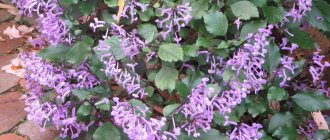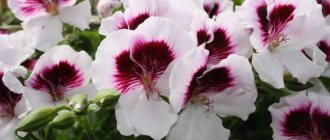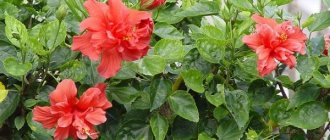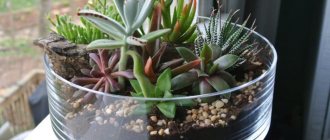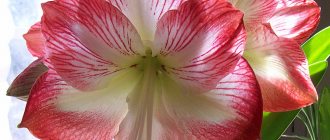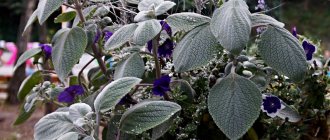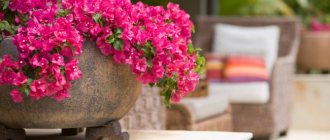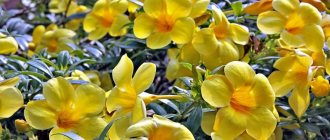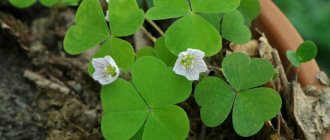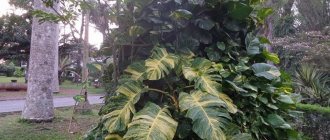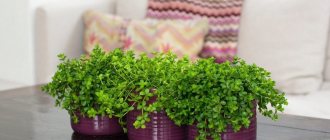An evergreen plant such as abelia (Abelia) is presented in the form of a shrub. Moreover, these deciduous bushes are not very tall. It belongs to the Linnaeaceae family. In the wild, abelia can be found in Mexico and Southeast Asia. This genus was named after the doctor Clark Abel, who was an Englishman and worked in China in the 19th century.
This beautiful flowering shrub has dark green foliage. These shiny leaves are arranged oppositely and have short petioles. Fragrant flowers, funnel-shaped or bell-shaped, are located on the apical and axillary peduncles. The oblong-shaped flowers consist of petals, the edges of which are slightly bent. They come in light pink or white color. The leathery small fruits, which have a curved or oblong shape, contain 1 seed.
This flower is often grown in greenhouses or used to decorate spacious rooms.
Description of the plant
Abelia (Abélia) is a deciduous or evergreen (semi-evergreen) slowly growing shrub with a height and diameter of usually one and a half to two and a half meters (sometimes up to six meters). The genus is named after Clark Abel (1780-1826), an English physician, botanist and zoologist, researcher of the flora and fauna of China, India, and Indonesia.
The leaves of the plant are opposite, paired, oval, pointed, usually dark green, shiny. The flowers are tubular (funnel-shaped, bell-shaped), five-lobed, fragrant. Usually small; the largest flowers - about 5 cm in diameter - are found in the species Abelia floribunda. There are five petals, they are usually white or pink, sometimes purple.
This plant, fascinating with its lush color, belongs to the Linnaeaceae subfamily of the Honeysuckle family (Caprifoliaceae). The genus is named after Clark Abel, an English physician, botanist and zoologist, researcher of the flora and fauna of China and India.
Abelia in the garden
Abelia is one of the most popular garden plants. Abelia is luxurious in the garden and blooms from June to September-October in the summer. There are both heat-loving species and fairly frost-resistant species.
Abelia: soil and replanting
The soil for abelia should be well-drained, slightly acidic with a pH of 5.5 to 7.2. The alkaline environment of the soil can lead to a lack of nutrients, which can cause the plant's leaves to turn yellow. Clay and loamy fertile soils are suitable. To plant a plant, you can take turf soil mixed with humus, deciduous soil and sand in equal parts.
Attention!!!
Since the plant is characterized by strong growth, two transshipments are necessary during the summer. Potted specimens can be replanted after two to three years.
Briefly about cultivation
- Flowering: from late May-early June until autumn.
- Lighting: bright diffused light with shading from direct sunlight or partial shade.
- Temperature: during the growing season - normal for a living room, in winter - 10-15 ºC.
- Watering: from spring to autumn - abundant, less intense in winter.
- Humidity: normal for residential premises.
- Feeding: during the growing season - twice a month with complex mineral fertilizer or organic solutions. In winter, fertilizing is not needed.
- Dormant period: from October to March.
- Transplantation: at a young age - twice per season, at a mature age - once every 2-3 years.
- Substrate: from equal parts of leaf and turf soil, peat, humus and sand.
- Reproduction: seeds and cuttings.
- Pests: thrips, aphids, spider mites, mealybugs and scale insects.
- Diseases: when the soil is waterlogged - root rot.
Read more about growing abelia below.
Abelia: care and reproduction
Caring for abelia is very simple; in the spring, dry shoots are removed from the plant, and long shoots are shortened to half. Abelia can withstand heavy pruning and can therefore be used to create a hedge.
Abelia reproduction
Abelia is propagated using young semi-lignified stem or apical cuttings, which are taken in July-August. Cut cuttings about 5 cm long and plant them in wet sand. The cuttings grow quickly; after two to three weeks they take root in a mixture consisting of sand, peat, and perlite. Young plants grow quickly and form a beautiful bush that needs to be shaped from time to time.
On a note!!!
Abelia flowers bloom until late autumn, which makes many gardeners want to have this plant in their garden.
Many species and varieties of abelia produce root shoots that are best suited for propagation. Young shoots are dug up with part of the root in the spring and transplanted to a new location.
Abelia can be propagated by seeds. Sowing of seed material is carried out in January. Seedlings grow quickly, and young plants can bloom in the same year.
8.Purpose
Plants are used in single and group plantings, when decorating edges, creating ridges and borders. Sometimes used as a hanging plant - in a flower pot it is a large spreading bush with drooping branches. In temperate climates, it successfully winters in open ground, but this requires deep planting. There are varieties of abelia with drooping shoots that can be successfully grown as hanging plants in hanging baskets.
↑ Up,
Abelia: care at home
Abelia at home is a relatively small plant with thin, long, drooping shoots colored pink and white. In adult plants, the length of shoots reaches one meter or more.
Indoor abelia
The small, oblong leaves, pointed at the top, located oppositely on the shoots, look unusual. Abelia is placed on windows facing south. In winter, it is advisable to create artificial lighting for the plant with fluorescent lamps. In summer, the flower can be taken out into the fresh air.
Possible problems
The plant does not bloom, its foliage turns pale - lack of lighting. You need to move the container to a brighter place.
The leaves turn yellow and dry, starting from the tips - insufficient soil and/or air moisture.
The watering and spraying regime should be optimized.
In summer, drying brown areas form on the leaves - sunburn. Abelia needs to be shaded.
Abelia: diseases
Abelia, like all other asthenia, is often attacked by pests and sometimes gets sick.
Aphid on abelia
Aphids often cause significant damage to young abelia bushes. One of the most harmless methods for fighting aphids is green potassium soap, 20 g of which is diluted in 1 liter of water and the plant is washed, covering the pot with soil with a film. Laundry soap is also harmful to aphids.
A good effect is achieved by the use of synthetic pyrethroids, which include a large group of drugs. The most common are decis and carat. The dosage and method of use are usually indicated on the packaging. The advantage of pyrethroids is their low toxicity.
Mob on abelia
Black spots often develop on the sugary secretions of abelia covering the leaves.
Insects are carefully cleaned from branches, leaves and stems with hard brushes, and the plants are treated with Vertimek solution every 5-6 days for 3 weeks.
spider mites and thrips
The plant is often affected by spider mites and thrips. To combat the pest, the drugs Vertimek, Nurell-D, and Mavrik are used.
A good remedy for spider mites is a decoction of cyclamen tubers. The active ingredient of cyclamen is saponin. To prepare the decoction, 50 g of tubers are dipped in 0.5 liters of water and boiled until they are boiled. The liquid is filtered through gauze, then the trunk, twigs and leaves affected by the mite are smeared with a brush. After 5-6 days, the treatment is repeated, after which all pests disappear.
A solution of Persian chamomile and green soap works: per liter of water you need 4 g of green soap and 5 g of chamomile infusion. Plants are sprayed with this liquid and washed with warm water after 24 hours. It is necessary to fight the tick until it is completely destroyed.
Abelia in the garden and at home brings gardeners a lot of joy. As a result of a little effort, the collection of plants can be supplemented with beautiful abelia, which will delight every day with its flowering.
Abelia: species
More than 30 species of this plant are known. The most common are Abelia chinensis, Abelia grandiflora, Abelia variegata, Abelia koreista, Abelia kaleidoscope, Abelia grandiflora, Abelia variegata and many others. Some types of abelia are grown as ornamental plants.
Abelia x grandiflora
This hybrid shrub is semi-evergreen (depending on humidity levels and temperature). When grown at home, abelia of this most common species has long, thin, drooping shoots.
Abelia x grandiflora
On a note!!!
It is noteworthy that while the plant is young, its shoots have a light pink tint.
The oppositely located small leaves have an oblong shape, pointed upward. These shiny leaves are dark green in color. The fragrant, fairly large axillary flowers are five-petaled and fused. The flowers collected in an inflorescence are painted white. Flowering is very long and abundant.
The most popular varieties:
- Francis Mason is a not very tall shrub with golden leaves.
- Edward Goucher - has red-purple leaves reaching 2 centimeters in length.
Chinese Abelia (Abelia chinensis)
This rather tall (up to 2 m) semi-evergreen shrub has many drooping and very graceful shoots. Its dark green leaves have an oval-pointed shape. And its bell-shaped flowers are white with small red streaks.
Chinese Abelia (Abelia chinensis)
Abelia floribunda
This evergreen shrub has pubescent light red stems as well as shiny dark green leaves that are quite wide. Quite long (up to 4 centimeters), fragrant bright pink flowers have a funnel shape. This abelia begins to bloom in May or June. Flowering lasts for several months in a row.
Abelia floribunda
Abelia shumannii
This delicate shrub is deciduous. Its oval leaves are dark green. Its flowers are lilac-pink, and flowering lasts from June to September.
Abelia shumannii
Abelia triflora
This deciduous and fairly resilient shrub sometimes has the size of a small tree. Its lanceolate leaves are dark green. Flowering begins in June. The flowers are pale pink in color.
Abelia triflora
Abelia mosanensis
The plant with the earliest flowering among abelias. Flowers with a pleasant jasmine scent, soft pink, tubular, collected in large inflorescences. The leaves are green, lanceolate, slightly bent along the central vein, the leaf blades are glossy. It is considered the most frost-resistant species.
Abelia mosanica
The flower has a stunning floral scent of a subtle blend of lilac, hyacinth and jasmine. The flowers are white, as if waxy, and bloom in late spring. Flowering lasts until early June. A hardy species, resistant to frost down to minus 15 °C.
Korean Abelia (Abelia biflora)
The most winter-hardy tall species that does not require shelter. Grows on rocky slopes, cliffs, among bushes, in the forests of the Russian Far East (southern part), northwestern China and Korea.
Abelia korean
The Korean abelia shrub grows slowly and reaches a height of 1 to 2.5 meters, has elongated ovate or lanceolate leaves 2.5 - 6.5 cm long and 1 - 3.5 cm wide. The flowers are tubular, rather small - about 2 cm. Blooms in June for three weeks to a month.
Abelia Kaleidoscope
This variety was recently bred and belongs to the large-flowered type. A distinctive feature of this species is the extremely varied color of the foliage - young spring leaves have a light green tint, over time they darken a little, and in summer they become golden yellow.
Abelia Kaleidoscope
In autumn, the plant decorates itself with a bright purple outfit. The center of the leaf blade is usually dark in color, such as brown. The flowers are large, fragrant, white or slightly pinkish.
Abelia corymbosa
A small shrub with a lush, rounded crown formed by many thin and flexible shoots. The leaves are dark green, hard, leaf blades with small teeth along the edge. The flowers are white or pink, tubular, with 5 rounded petals, fragrant, collected in large inflorescences - corymbs.
Abelia corymbosa
Abelia Edward Goucher
The shrub is distinguished by a very long flowering period and the color of the buds - they can be pink and even burgundy. Young leaves that appear at the tops of the stems are copper-brown, while adults have a dark green color, which changes to a bronze tint in autumn.
Abelia Edward Goucher
Abelia Lavender Mist
A compact shrub with glaucous foliage that turns purplish-red in autumn and deep purple in winter. The flowers are lavender and white, characterized by two flowering periods in June and August.
Abelia Little Richard
Abundantly flowering dwarf round and dense bush. The green leaves turn orange-pink in the fall.
Abelia Frances Mason
A dwarf variegated variety with yellow-green foliage.
Abelia Mardi Gras
The size of the variegated variety is 50-80 cm in height and a meter in width. The leaves are colored pink, green and white. After frost, the bush becomes copper in color. The flowers are fragrant, pink.
The group of varieties with golden foliage stands out especially. Sedi them:
- "Keats gold";
- "Super Gold";
- "Little Gold"
Abelia is a beautiful shrub that can decorate any flower bed or flower garden. And if the area allows, it must be planted in the garden area.
